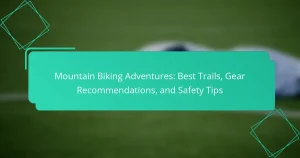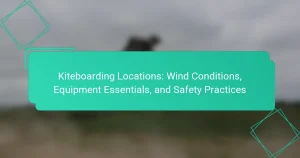Caving offers unique exploration opportunities and physical challenges for adventure seekers. Discover the best caving locations worldwide, essential safety precautions, and vital gear for a successful experience. Learn about the stunning geological formations and ecosystems while ensuring your safety and enjoyment. Prepare for an unforgettable journey into the depths of the earth.

What are the top caving locations worldwide?
The top caving locations worldwide include Mammoth Cave in the USA, Waitomo Caves in New Zealand, and Carlsbad Caverns in New Mexico. Each location offers unique geological formations and experiences for caving enthusiasts.
Mammoth Cave is renowned for its extensive underground system, stretching over 400 miles. Waitomo Caves features stunning glowworm displays, creating a magical atmosphere. Carlsbad Caverns boasts impressive limestone formations and a large bat population, making it a popular destination for both caving and wildlife observation.
Safety precautions are essential in caving. Always wear appropriate gear, including helmets and sturdy footwear. It’s crucial to stay with a group and inform someone of your plans.
Essential gear includes a reliable headlamp, gloves, and a first aid kit. Hydration packs and snacks are advisable for longer explorations. Each of these locations provides guided tours, ensuring safety and enhancing the experience.
Which regions are known for their unique cave systems?
Regions known for unique cave systems include the United States, Mexico, Slovenia, and Vietnam. The Mammoth Cave in Kentucky is the longest cave system globally. The Caves of Aggtelek in Hungary showcase stunning limestone formations. The Waitomo Caves in New Zealand are famous for their glowworms. The Sơn Đoòng Cave in Vietnam is the largest cave in the world, featuring a unique ecosystem. Each region offers distinct geological features and caving experiences.
What makes certain caves more accessible for beginners?
Certain caves are more accessible for beginners due to their straightforward paths, minimal technical requirements, and well-maintained facilities. Features like wide openings, stable ground, and good lighting enhance safety and comfort. Popular beginner-friendly caves often include guided tours, which provide additional support. Locations with easy access and nearby amenities further increase their appeal for novice cavers.
How do seasonal changes affect caving conditions?
Seasonal changes significantly impact caving conditions. Temperature fluctuations can affect cave humidity and water levels, influencing accessibility and safety. For instance, heavy rainfall can lead to flooding, while winter temperatures may freeze cave entrances. These factors necessitate careful planning and preparation for caving trips.
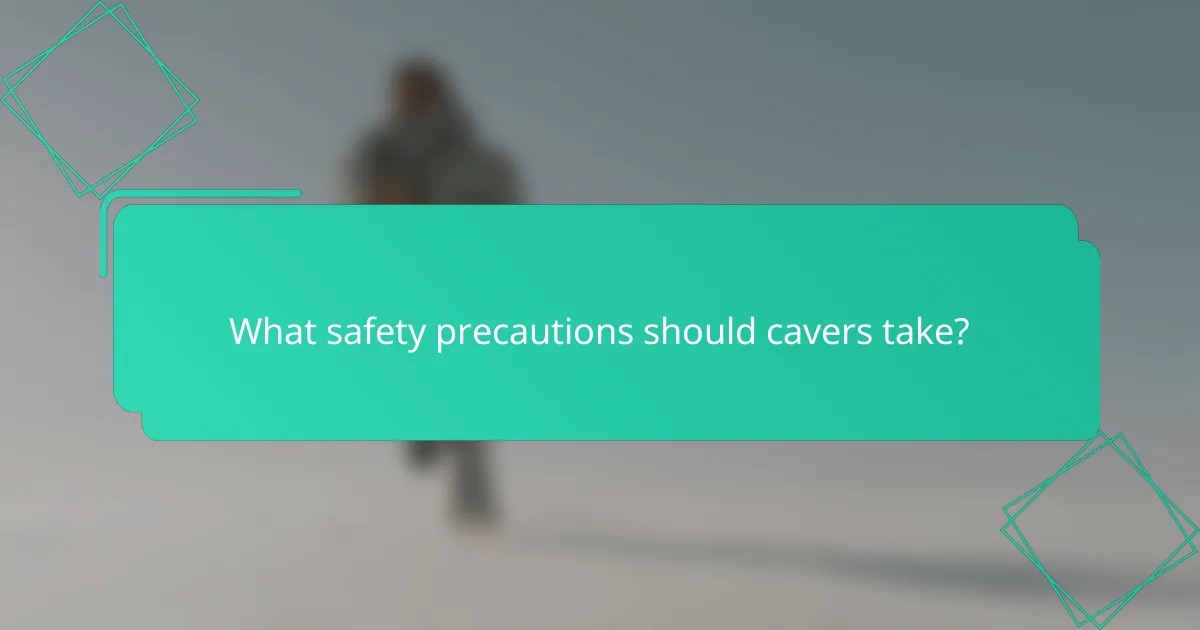
What safety precautions should cavers take?
Cavers should take several safety precautions to ensure a safe experience. Always inform someone about your caving plans. Use proper gear, including helmets, headlamps, and sturdy footwear. Check weather conditions and avoid caves during heavy rainfall. Carry a first aid kit and know basic first aid procedures. Stay with your group and establish a buddy system to prevent anyone from getting lost. Familiarize yourself with the cave layout and potential hazards.
How to prepare for potential hazards in caves?
To prepare for potential hazards in caves, conduct thorough research, carry essential gear, and follow safety protocols. Familiarize yourself with the cave’s layout and potential risks such as rock falls or flooding. Always inform someone of your plans and expected return time.
1. Research the cave environment and conditions.
2. Equip yourself with proper gear including helmets, headlamps, and first aid kits.
3. Travel in groups for safety and support.
4. Carry emergency supplies like food, water, and communication devices.
5. Stay aware of your surroundings and avoid risky areas.
What essential first aid knowledge is needed for caving?
Essential first aid knowledge for caving includes basic wound care, CPR, and recognizing hypothermia signs. Familiarity with splinting techniques and the use of a first aid kit is crucial. Understanding how to handle fractures and sprains can significantly improve safety during caving experiences.
Which safety gear is critical for caving adventures?
Critical safety gear for caving adventures includes a helmet, headlamp, gloves, knee pads, and sturdy footwear. Each item protects against potential hazards. Helmets shield against falling debris. Headlamps provide essential illumination. Gloves enhance grip and protect hands. Knee pads cushion falls. Sturdy footwear prevents slips and injuries.

What essential gear do cavers need?
Cavers need essential gear for safety and comfort, including a helmet, headlamp, gloves, and sturdy footwear. These items ensure visibility, protection, and grip in challenging environments. Additionally, a harness and climbing gear may be necessary for vertical caving. A first-aid kit is crucial for emergencies.
How does gear choice vary by cave type?
Gear choice varies significantly by cave type due to differing environmental conditions and challenges. In limestone caves, lightweight helmets and headlamps are essential for visibility, while in wet caves, waterproof gear and sturdy footwear are crucial for traction.
In ice caves, specialized gear like crampons and ice axes are necessary for safety. For volcanic caves, protective clothing against sharp rocks and high temperatures is vital. Each cave type demands tailored gear to ensure safety and enhance the caving experience.
What are the best brands for caving equipment?
Some of the best brands for caving equipment include Petzl, Black Diamond, Mammut, and Wild Country. These brands are known for their durable helmets, harnesses, and lighting systems essential for safe caving experiences. Petzl offers innovative headlamps with high luminosity, while Black Diamond provides reliable climbing gear. Mammut is recognized for its robust ropes, and Wild Country specializes in protective gear. Each brand emphasizes safety and performance, making them top choices for caving enthusiasts.
How to maintain and care for caving gear?
To maintain and care for caving gear, regularly inspect, clean, and store it properly. Rinse gear after each use to remove dirt and moisture, especially for ropes and harnesses. Dry everything thoroughly to prevent mold and mildew. Store gear in a cool, dry place away from direct sunlight. Check for wear and tear, replacing any damaged items promptly to ensure safety during caving adventures.
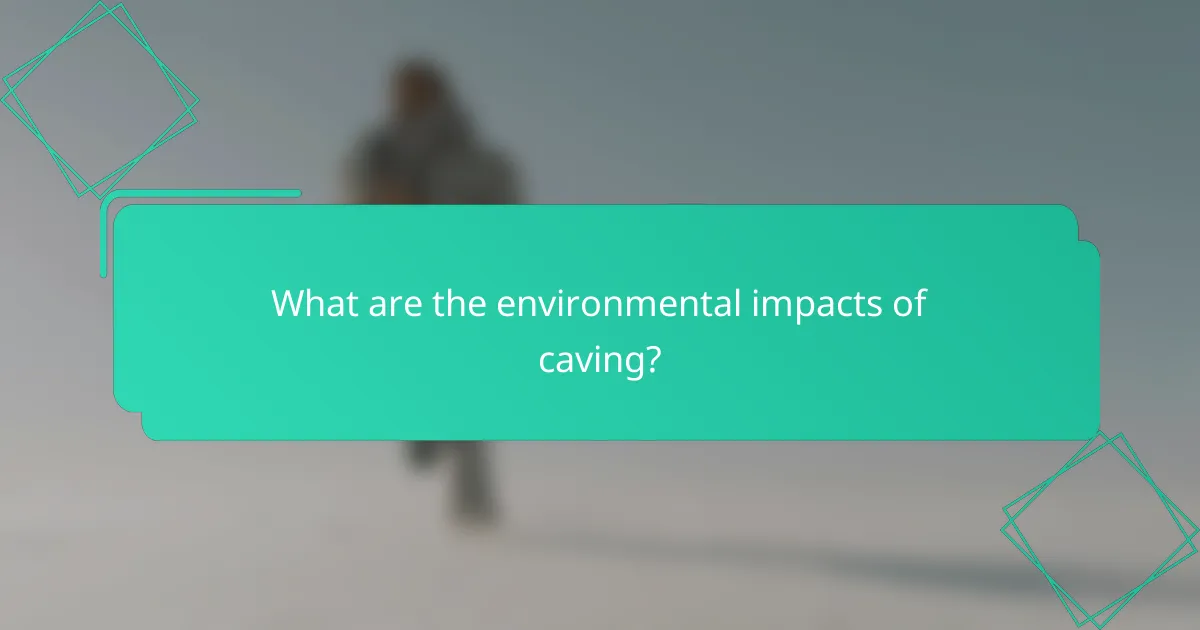
What are the environmental impacts of caving?
Caving can significantly impact the environment through ecosystem disruption and pollution. Disturbance to cave-dwelling species can lead to population decline. Furthermore, human waste and litter can contaminate water sources. Preservation efforts are crucial to mitigate these effects and protect fragile cave ecosystems.
How can cavers minimize their ecological footprint?
Cavers can minimize their ecological footprint by following responsible practices. They should stick to established trails to avoid disturbing wildlife and vegetation. Carrying out all trash, using biodegradable products, and avoiding noise pollution further protect cave ecosystems. Additionally, cavers should educate themselves about local regulations and conservation efforts.
What conservation efforts are in place for popular caving sites?
Conservation efforts for popular caving sites include habitat protection, visitor education, and sustainable tourism practices. Organizations implement monitoring programs to track ecological health and enforce regulations to minimize human impact. For example, the National Park Service manages cave ecosystems by limiting access and promoting responsible exploration.
Which rare cave formations should be preserved?
Preserving rare cave formations is crucial for ecological balance and heritage. Notable formations include the Giant’s Causeway in Ireland, known for its unique hexagonal basalt columns, and the Waitomo Glowworm Caves in New Zealand, famous for bioluminescent insects. The Lechuguilla Cave in New Mexico features rare mineral formations and delicate ecosystems. Each of these sites harbors unique attributes that contribute to their scientific and aesthetic value, making preservation essential for future generations.

What are the common challenges faced by cavers?
Cavers commonly face challenges such as navigation difficulties, physical hazards, and equipment failures. These issues can hinder safety and enjoyment during caving experiences.
Navigation can be complicated due to complex cave systems, leading to disorientation. Physical hazards include slippery surfaces, low ceilings, and unstable rock formations, which can cause injuries. Equipment failures, such as malfunctioning lights or inadequate gear, can also pose significant risks.
Proper preparation and awareness of these challenges are essential for a safe and enjoyable caving adventure.
How do physical fitness levels affect caving experiences?
Physical fitness levels significantly enhance caving experiences by improving endurance, strength, and agility. Fit individuals can navigate challenging terrains, manage long durations underground, and respond effectively to unexpected situations. Enhanced physical condition reduces fatigue and increases safety, allowing for more enjoyable exploration. Additionally, fitness levels can influence the choice of caving locations, with more physically demanding caves requiring better preparation and capability.
What psychological challenges can arise during caving?
Caving can lead to psychological challenges such as anxiety, claustrophobia, and disorientation. These issues often arise due to the confined spaces and darkness encountered in caves. Anxiety may stem from fear of getting lost or encountering hazards. Claustrophobia can intensify feelings of panic in tight areas. Disorientation can occur from the lack of natural light and complex cave systems. Awareness and preparation can help mitigate these psychological effects during caving experiences.
How to navigate and orient oneself in unfamiliar caves?
To navigate and orient oneself in unfamiliar caves, rely on a combination of maps, compasses, and natural landmarks. Familiarize yourself with cave markings and use a headlamp for visibility.
1. Prepare by studying cave maps before entering.
2. Use a compass to maintain direction.
3. Mark your path with tape or chalk.
4. Take note of significant formations as reference points.
5. Stay calm and retrace steps if lost.
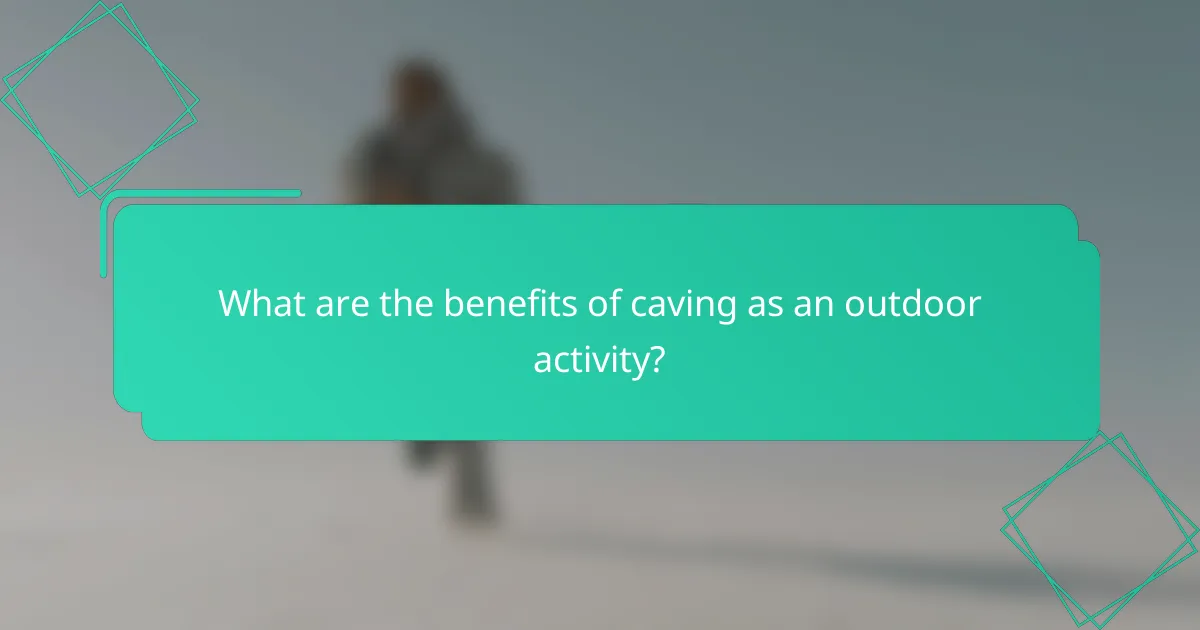
What are the benefits of caving as an outdoor activity?
Caving offers numerous benefits, including physical fitness, mental stimulation, and unique exploration opportunities. It enhances strength, endurance, and flexibility through climbing and navigating challenging terrains. Caving also fosters teamwork and problem-solving skills as participants work together to overcome obstacles. Additionally, it provides a chance to connect with nature, experience stunning geological formations, and learn about ecosystems. Safety education and proper gear further enhance the experience, making caving both thrilling and secure.
How does caving contribute to physical fitness?
Caving significantly enhances physical fitness through strength building, endurance, and flexibility. The activity requires climbing, crawling, and navigating uneven terrain, which engages multiple muscle groups. As a result, participants improve cardiovascular health and overall body strength. Additionally, caving promotes mental resilience and problem-solving skills, contributing to a well-rounded fitness experience.
What social benefits can come from caving with groups?
Caving with groups fosters teamwork, builds friendships, and enhances communication skills. Participants often share experiences that strengthen social bonds. Engaging in caving activities can also promote a sense of community and mutual support. Additionally, caving encourages shared learning, as individuals exchange knowledge about techniques and safety measures.
Which skills can be developed through caving experiences?
Caving experiences can develop skills such as teamwork, problem-solving, and physical fitness. Participants learn to navigate challenging environments, enhancing their adaptability and communication skills. Additionally, caving fosters a sense of responsibility regarding safety and environmental conservation.
What expert tips can enhance the caving experience?
To enhance your caving experience, prioritize safety, choose the right gear, and select suitable locations.
1. Research locations: Identify caves that match your skill level and interests.
2. Invest in quality gear: Essential items include a helmet, headlamp, gloves, and durable boots.
3. Plan your route: Familiarize yourself with cave maps and potential hazards.
4. Stay hydrated and nourished: Bring enough water and energy-rich snacks.
5. Go with a group: Caving is safer and more enjoyable with companions.
6. Follow safety protocols: Always inform someone of your plans and expected return time.
